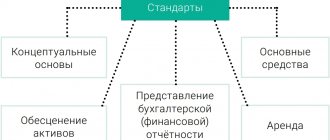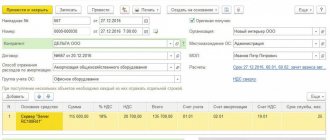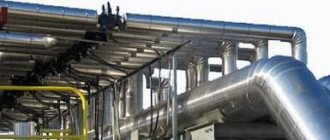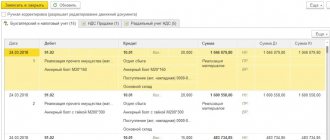Fixed Asset Accounting
An asset can be recognized as a company's fixed asset only if it meets the following criteria:
- purpose – production activity of the company
- The intended use period is 12 months or more.
- the owner does not plan to put this asset up for sale
- property is a resource and can bring benefits
Such verification of an asset for compliance is prescribed by the PBU accounting for fixed assets and is mandatory for all companies.
It turns out that only buildings, equipment, transport, as well as breeding livestock and plantings can be recognized as OS, taking into account the criteria.
IMPORTANT: when creating a list of fixed assets, always take into account the cost criterion for assigning assets, set out in your accounting policy.
Accounting for receipt of fixed assets
Accounting accounts are designed to carry information about all movements of objects, including the receipt of fixed assets. All procedures are clearly regulated. In fact, all accountants in the country use the same operations when a company acquires fixed assets: guidelines for accounting for fixed assets dictate uniform rules. You can choose the option of calculating depreciation amounts and the cost limit for assignment to fixed assets.
IMPORTANT: materials, finished products, and objects for resale are not considered fixed assets, even if all other recognition criteria are met.
Inventory accounting of fixed assets and intangible assets
The unit of accounting for fixed assets and intangible assets is an inventory object. It can be a cabinet, a computer, or an entire production complex. The main thing is that all parts of the asset have the same useful life. Otherwise, they must be taken into account in parts.
Account 01 “Fixed assets”
Analytical accounting of fixed assets is carried out at their original cost, which consists of the actual costs of bringing a particular asset to working condition. Since 2021, there is a different limit for accounting for fixed assets, and in tax and accounting it may be different.
Fixed assets in accounting 2017 cost
40,000 and above - this is the limit for fixed assets in accounting now. Perhaps, starting from 2021, the legislator will raise the bar to 100,000 and the limit will be equal to the tax limit. This will avoid unwanted timing differences. But for now, fixed assets are accepted for accounting according to the old rules, while in tax accounting there is already a limit of 100 thousand rubles. and above, starting from 01/01/16. But what if the object lasts more than 12 months, but costs less than the established limit? According to current rules, it can be immediately written off as an expense.
IMPORTANT: you need to carefully calculate the initial cost of the object, since the final amount directly affects the decision - to write off or depreciate the asset.
Actual expenses that form the initial price of the OS:
- payment to the seller and contractor under the contract
- costs for delivery and final installation of the asset
- customs payments and import fees
- state duties on the object
Fixed assets in the accounting of a budgetary institution or commercial enterprise calculate the initial price of the object according to uniform rules. No indirect costs can increase the cost of a company's inventory resource, regardless of the company's legal form. The accounting unit of fixed assets is a capital object or non-current asset, all parts of which transfer their value to costs according to the same rules.
Postings for accounting for the receipt of fixed assets at the enterprise:
| Dt | CT | Content |
| 01 | 08 | Acceptance of fixed assets for accounting |
| 68.2 | 19 | VAT refund |
| 26 | 02 | Depreciation on computers |
| 20 | 02 | Depreciation of production machines |
| 01 | 10,60,70,69 | Modernization of fixed assets accounting and tax accounting |
| 08 | 60 | Buying a new machine |
| 19 | 60 | Tax on capitalized assets |
| 60 | 51 | Settlements with the supplier |
Limit on the value of fixed assets in 2021
According to PBU 06/01, assets are depreciable if their limit is over 40 thousand rubles, and they simultaneously have the following characteristics:
- intended for the manufacture of goods, provision of services or work;
- period of use – more than 12 months;
- objects are not for resale to contractors; The goal is to bring benefits to the company.
These criteria have been in effect since 2011 and have not changed to date. In 2021 Amendments to the PBU are expected.
Soon PBU 06/01 will be named as the Federal Accounting Standard for “Fixed Assets”. The draft standard was developed by the Accounting Development Fund “NRBU “BMC”.
The Ministry of Finance promises that the standard will be mandatory for everyone no earlier than 2021. As soon as it comes into force, the company will be able to apply it voluntarily. Transition period – 2021. The new standard will be closer to IFRS (International Financial Reporting Standards). According to the project, the cost threshold for assets will disappear. Now, as we have already noted, it is 40 thousand rubles. But from 2021, companies will be able to set a limit on the cost of fixed assets and 100 thousand rubles, thereby making it equal to tax accounting.
With the standard, the company will have the right to independently choose the frequency of depreciation. That is, you can write off the value of an asset once a year or more often. Now depreciation is monthly (clause 19 of PBU 6/01). According to the new rules, organizations will also have new responsibilities - at least once a year to check and, if necessary, adjust the useful life of assets. Now, according to the rules of PBU, you only need to do this if you have reconstructed or modernized the facility (clause 20 of PBU 6/01). The starting point for calculating depreciation will also change. According to PBU 06/01, it must be accrued from the 1st day of the month following the month in which the fund was registered (clause 21 of PBU 6/01). According to the standard - from the day the object is completely ready for use. This can be any day of the week, month, quarter or year.
Limit on the value of fixed assets in tax accounting in 2017
In the new year, in tax accounting, property is considered depreciable if its value exceeds 100 thousand (Article 256 of the Tax Code of the Russian Federation). The new criterion has been in effect for a year, but only for those facilities that have been in operation since 2021. For 2021, the rules will not change, which means that objects less than 100 thousand rubles must be written off immediately, and those more expensive must be depreciated. But here it is important not to get confused about how to write off a low value asset - the price of an asset is up to 40 thousand rubles. Indeed, in 2016, taking into account the new amendments, confusion arose. Due to the fact that in accounting the value of fixed assets remained the same - 40 thousand rubles, companies wrote off the low value immediately - at once, and assets from 40 to 100 thousand rubles - gradually.
The Ministry of Finance in a letter dated May 20, 2016 No. 03-03-06/1/29194 explained that this is incorrect. If an organization writes off assets from 40 to 100 thousand rubles gradually in tax accounting, then the same procedure should be applied to low-value fixed assets. For example, workwear, equipment, inventory, equipment, etc. But one can argue with the position of the Ministry of Finance. After all, the Tax Code of the Russian Federation allows organizations to independently determine how to write off low-value objects. And nowhere are there predetermining rules that the same approach to writing off assets must be used. As a general rule, the company has the right to write off a low value immediately. And if the company gradually takes into account part of the objects, it will overestimate the tax, and not underestimate. In essence, there is no reason to argue with inspectors, but due to the position of the Ministry of Finance, claims from tax authorities cannot be avoided. If you are not ready to argue, then use a single write-off method. There are the following options: consider all assets up to 100 thousand rubles in expenses immediately or gradually.
Accountant on remote access, outsourced accountant needed, outsourced accountant Moscow
Remote accountant required, looking for a remote accountant, outsourcing accounting services, accounting outsourcing
Remote accounting required, outsourced accounting, outsourced accounting, accounting services
Accounting for disposal of fixed assets
The reasons for the disposal of assets from accounting in an organization may be the following actions and events:
- the company sold the property
- the company wrote off an obsolete or dilapidated asset
- The legal entity transferred the object as a treasure to the capital of another company
- re-registration of property by exchange
- transfer of property as a gift
This is just a short list of reasons for recording the receipt and disposal of fixed assets simultaneously for several companies. One of the basis for new accounting entries is the lease agreement.
Accounting for lease of fixed assets
The contract is based on the rules of law set out in Chapter. 34 Civil Code of the Russian Federation. The object can be any property. For organizations, this is most often OS; the main thing is that the asset meets the criteria of thematic PBU 6 01.
Accounting for leased fixed assets is carried out depending on the selected balance holder. This may be a tenant or a landlord-owner. When it comes to operating leases, the owner always keeps records.
To account for leased property, the following subaccounts are provided in account 03 Income investments in MC:
03.1 MC in the organization
03.2 MC in possession and use
03.3 MC for temporary use
Most often they are used by leasing companies when recording property leased to their counterparties. Next, these objects are depreciated according to general rules using subaccount 02.2 Depreciation of objects account. 03.
If renting is the main activity, the postings will be as follows:
| Dt | CT | Content |
| 08 | 60 | Purchase of a non-current asset |
| 19 | 60 | VAT on asset for leasing |
| 60 | 51 | Payment to supplier/contractor |
| 68.2 | 19 | VAT refund |
| 03 | 08 | Transfer of an object for financial lease |
| 62 | 90 | Accrual of rental revenue |
| 90 | 68.2 | VAT on leasing payment |
| 51 | 62 | Receiving rent money from a client |
| 20 | 02.2 | Depreciation is calculated every month |
If the lease is long-term with subsequent purchase, the object will be transferred to the balance sheet of the tenant, and in the owner’s accounting it will be reflected in the off-balance sheet account 011 fixed assets leased.
In connection with the practice of convergence of RAS and IFRS, there is a tendency to reflect leases according to the rules of international standards:
- operating lease – always on the owner’s balance sheet
- finance lease – only on the balance sheet of the lessee
Features of fixed assets accounting for financial leases
The organization of accounting for fixed assets under financial lease according to IFRS has its own nuances. But first you need to determine whether the agreement meets the recognition criteria for a finance lease:
- The term of the contract is equal to the useful life of the property
For example, the SPI of a machine is 6 years, the term of the lease agreement is 5.5 or 6 years - financial lease according to IFRS criteria
- At the end of the lease period, the property can be purchased at a reduced price
If the contract is established for a number of years approximately equal to the SPI, and the redemption payment at the end of the term is conditional, say, 1,000 rubles. is a finance lease
- When one lease term ends, the tenant can extend it
For example, renting a car is 50,000 rubles/month, the tenant leased the car for 3 years, but can extend the contract on preferential terms - this is FA
Once the FA criteria are met, the accountant must make the following conclusions:
- synthetic accounting of fixed assets is carried out by the tenant on his balance sheet
- for the tenant this is income from the placement of working capital
- the owner does not charge depreciation, but reflects the remuneration
For example, the following accounting entries are possible:
Accounting for fixed assets in finance leases
| Dt | CT | the name of the operation |
| 08 | 60 | Purchase of the leased asset by the lessor company under a financial lease (leasing) agreement from a supplier agreed upon by the parties |
| 19 | 60 | VAT is reflected on the principal amount of payment for fixed assets under leasing |
| 03.1 | 08 | The posting is generated when the asset is ready to be leased |
| 76 | 98 | For the entire amount of the contract when transferring property to the lessee’s balance sheet (lessor’s cost) - will be reduced monthly according to the rental service/revenue accrual schedule |
| 03.9 | 03.1 | Disposal of an object based on the contractual contract (supplier cost) |
| 97 | 03.9 | The cost of the leased item under the agreement with the supplier will be written off as current expenses of the period on a monthly basis (analogous to depreciation) |
| 011 | Off-balance sheet accounting of the leased asset - the financial lease object in the accounting of the owner-lessor |
Tax accounting of fixed assets in 2021
Starting from 2021, in accordance with tax law, there is a new value limit in accounting - 100 thousand rubles. This means that all objects whose value is below the limit are subject to a one-time write-off without depreciation.
IMPORTANT: The Tax Code of the Russian Federation does not offer taxpayers the right to choose: the cost limit of 100,000 for NU is the same for everyone, regardless of the accounting policy of the enterprise.
It turns out that you can write off relatively cheap items according to the rules of the Tax Code of the Russian Federation faster than in accounting, where there is a limit of up to 40,000 rubles. This means that temporary tax differences will arise that must be reflected in accounting in accordance with PBU 18/02.
Tax accounting of fixed assets in simplified format
As for the cost limit, it is accepted for everyone: both simplifiers and companies using OSNO take into account fixed assets in the same way. Although there are some nuances for the simplified tax system:
- the ability to write off the cost of fixed assets as period expenses in parts (its own specifics of value transfer)
- the right to attribute investments in material assets to expenses immediately at the time of payment (analogy with the cash method of accounting)
However, accountants using the simplified tax system must proceed from the same limit of the Tax Code of the Russian Federation for depreciable property as specialists in companies operating under the general regime.
We spoke in detail about the features of accounting for non-current assets of enterprises to help avoid errors and inaccuracies associated with changes in current legislation.
Cost limits
In accounting, property worth up to 40,000 rubles can be legally written off as expenses at a time (PBU 6/01). This means that it does not need to be taken into account on account 01 and amortized.
The situation is completely different in tax accounting. Fixed assets more expensive than 100,000 rubles must be depreciated; anything cheaper will have to be written off immediately as expenses (Clause 1, Article 256 of the Tax Code of the Russian Federation). This rule applies only to property put into operation after December 31, 2015.
Submit electronic reports via the Internet. The Kontur.Extern service gives you 3 months free of charge!
Try it
Let us summarize the rules for accounting for fixed assets.
1.OS up to 40,000 rubles
Accounting: can be written off as expenses immediately as part of the inventory or registered as a fixed asset and depreciation charged.
Tax accounting: write off immediately upon commissioning as costs.
2.OS from 40,000 to 100,000 rubles
Accounting: register as a fixed asset and calculate depreciation.
Tax accounting: write off immediately upon commissioning as costs.
3.OS more expensive than 100,000 rubles
Accounting: register as a fixed asset and calculate depreciation.
Tax accounting: register as a fixed asset and calculate depreciation.
As you can see, the tax and accounting rules for fixed assets unconditionally coincide if the property is more than 100,000 rubles. You can compare tax and accounting when purchasing an operating system less than 40,000 rubles by writing off the property as expenses at a time.
In all other cases, temporary differences will arise (PBU 18/02).
However, in tax accounting, non-depreciable property up to 100,000 rubles can be written off in parts (clause 3, clause 1, article 254 of the Tax Code of the Russian Federation). But in this case, it is safer to write off in the same way property worth up to 40,000 rubles, and valued from 40,000 to 100,000 rubles.
Submit electronic reports via the Internet. The Kontur.Extern service gives you 3 months free of charge!
Try it






